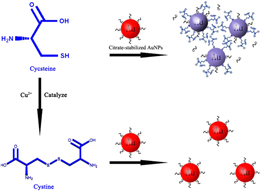肉眼によるCu2+の超高感度検出およびイムノアッセイへの応用
Ultrasensitive detection of Cu2+ with the naked eye and application in immunoassays.
2012年3月16日 NPG Asia Materials 4, e3 (2012) doi:10.1038/am.2012.18
比色検出:目に見える変化

福州大学(中国)のHuang-Hao Yangをはじめとする研究チームはこのたび、銅イオン(Cu2+)を非常に高い感度で検出する方法を考案した。銅イオンは、その体内蓄積がいくつかの病気と関連付けられている金属イオンである。研究チームが今回用いたのは、金ナノ粒子を利用した方法だ。金ナノ粒子は、凝集すると溶液の色を赤色から紫色に変えるため比色センシングによく使われるが、ここでは、銅イオンはその凝集を直接引き起こすのではなく、アミノ酸単量体(システイン)の酸化による二量体(シスチン)生成反応の触媒として働く。金ナノ粒子の凝集を誘発するのはシステインのみのため、銅イオンが存在すると溶液は赤色に、銅イオンが存在しないと溶液は紫色になる。この方法では、呈色は触媒量の僅かな銅イオンで起こり、感度は非常に高い。研究チームはさらに、この迅速かつ簡便な高感度検出法をヒトタンパク質のイムノアッセイに利用している。
Colourimetric detection: A very visible variation
Huang-Hao Yang and co-workers at Fuzhou University have devised an ultra-sensitive method to detect copper ions (Cu2+), whose accumulation in the body has been linked to several diseases. The researchers' method relies on gold nanoparticles, popular in colourimetric sensing because they turn a solution from red to purple on aggregation. Here, however, instead of triggering the aggregation directly, the copper ions catalyse a ‘supporting reaction’ – the oxidation of a monomeric amino acid (cysteine) into a dimeric one (cystine). Only cysteine triggers the aggregation of the nanoparticles, which means the presence or absence of copper results in a red or purple solution, respectively. The method's sensitivity is very high because only catalytic quantities of copper are needed. The researchers further used this rapid, convenient, sensitive method in an immunoassay for a human protein.

